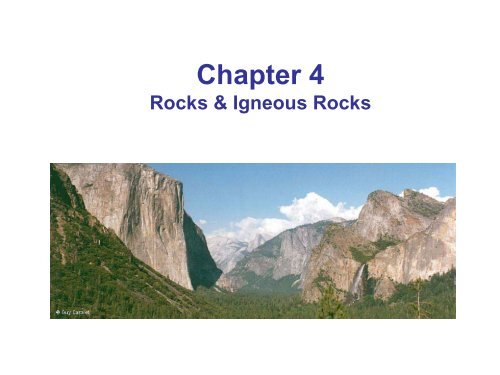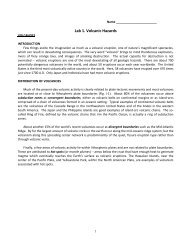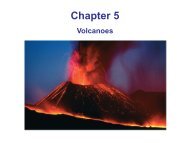Chapter 4 Rocks and Igneous Rocks (.pdf)
Chapter 4 Rocks and Igneous Rocks (.pdf)
Chapter 4 Rocks and Igneous Rocks (.pdf)
Create successful ePaper yourself
Turn your PDF publications into a flip-book with our unique Google optimized e-Paper software.
<strong>Chapter</strong> 4<br />
<strong>Rocks</strong> & <strong>Igneous</strong> <strong>Rocks</strong>
Rock Definition<br />
A naturally occurring consolidated mixture of<br />
one or more minerals<br />
e.g, marble, granite, s<strong>and</strong>stone, limestone
Rock Definition<br />
Must naturally occur in nature, cannot be man-made<br />
Is a solid, not gas, ice or liquid<br />
Composed of one or more minerals
Exceptions to the Definition<br />
Some rocks are not formed of minerals<br />
Noncrystalline, glassy volcanic rocks such as<br />
obsidian <strong>and</strong> pumice<br />
Coal which is formed from compacted plant remains
Appearance of a Rock<br />
The appearance of a rock is determined by<br />
two major factors<br />
Mineralogy<br />
Texture
Appearance of a Rock<br />
Mineralogy refers to the relative proportions of the<br />
constituent minerals<br />
Texture is determined by the size, shape <strong>and</strong><br />
arrangement of the mineral crystals
Appearance of a Rock<br />
Mineralogy <strong>and</strong> texture are related<br />
to how <strong>and</strong> where a rock was<br />
formed <strong>and</strong> what has happened to<br />
the rock since it was created
Three Great Families of <strong>Rocks</strong><br />
<strong>Igneous</strong><br />
Sedimentary<br />
Metamorphic
Three Types of <strong>Rocks</strong>
<strong>Igneous</strong> <strong>Rocks</strong><br />
<strong>Rocks</strong> formed by the solidification of magma<br />
(molten rock)<br />
Granite
Two Types of <strong>Igneous</strong> <strong>Rocks</strong><br />
Extrusive igneous rocks<br />
form when magma erupts<br />
at the surface (i.e., above<br />
ground) <strong>and</strong> rapidly cools<br />
Intrusive igneous rocks<br />
form when magma<br />
intrudes into bedrock <strong>and</strong><br />
slowly cools (i.e., below<br />
ground)
<strong>Igneous</strong> <strong>Rocks</strong>
<strong>Igneous</strong> Rock Texture<br />
Intrusive rocks such as granite are coarse<br />
grained (can easily see the grains with the<br />
unaided eye)<br />
Extrusive igneous rocks such as basalt are<br />
glassy or fine grained
Most <strong>Igneous</strong> Rock are Silicates<br />
Quartz<br />
Feldspar<br />
Mica<br />
Pyroxene<br />
Amphibole<br />
Olivine<br />
Basalt
Granite
Sedimentary <strong>Rocks</strong><br />
<strong>Rocks</strong> formed by consolidation of sediments<br />
Classified by the type of sediments
Two Major Types of Sediments<br />
Clastic sediments are physically deposited<br />
particles derived from weathered rocks<br />
Chemical <strong>and</strong> biochemical sediments include<br />
minerals carried in solution such as calcite <strong>and</strong><br />
halite
From Sediments to Solid <strong>Rocks</strong><br />
Lithification is the process of converting sediments<br />
into solid rocks<br />
(will cover in detail in another lecture)
The Two Types of Lithification<br />
Compaction – sediments are squeezed together by<br />
the weight of overlying sediments into a solid mass<br />
Cementation – minerals precipitate around the<br />
sediments <strong>and</strong> bind them into a solid rock
Sedimentary <strong>Rocks</strong>
Sedimentary <strong>Rocks</strong><br />
5 % by volume of the upper crust<br />
75 % by exposed surface area of continents
Sedimentary <strong>Rocks</strong><br />
Sedimentary rocks commonly contain fossils<br />
In fact, some sedimentary rocks are almost entirely<br />
composed of fossils<br />
Can exhibit extensive horizontal layers called<br />
bedding
Composition<br />
Sedimentary rocks can be<br />
composed of sediments<br />
created from any of three<br />
great families of rock<br />
(igneous, sedimentary,<br />
metamorphic)<br />
Chemical cementation<br />
commonly includes<br />
calcite, gypsum <strong>and</strong><br />
halite
Metamorphic <strong>Rocks</strong><br />
Metamorphic rocks are formed by the transformation<br />
of previously-existing rocks in the solid state due to<br />
increased temperature <strong>and</strong> pressure
Metamorphic <strong>Rocks</strong><br />
Metamorphism can change the mineralogy, texture<br />
<strong>and</strong>/or the chemical composition of a “parent rock”<br />
while maintaining its solid form<br />
Note that the rock does not melt (temperature range<br />
250 to 700 C)
Regional <strong>and</strong> Contact<br />
Metamorphism<br />
Regional metamorphism occurs where high<br />
temperature <strong>and</strong> pressures occur over large<br />
region (plate tectonics)<br />
Contact metamorphism is limited to smaller<br />
areas such as around a magma intrusion into<br />
bedrock
Regional Metamorphism
Contact Metamorphism
Other Forms of Metamorphism<br />
Ultra-high pressure metamorphism occurs deep<br />
in the continental <strong>and</strong> oceanic crust<br />
High-pressure, low-temperature metamorphism<br />
occurs where oceanic crust subducts under a<br />
continental plate<br />
Shock metamorphism at impact sites
Metamorphic Mineralization<br />
Silicates are the most common mineral in<br />
metamorphic rocks<br />
Minerals can tell you the “grade”of metamorphism<br />
Certain minerals are<br />
uniquely<br />
characteristic of<br />
metamorphic rocks<br />
(kyanite, staurolite,<br />
some garnets)
Metamorphic Mineralization<br />
Contact Ultra-high pressure Regional High-press, low-temp
Proportions of the Rock Types
A Few More Facts…<br />
<strong>Igneous</strong> processes create new rock<br />
Metamorphic <strong>and</strong> sedimentary processes<br />
re-work old rock into a new form<br />
Silicate mineral are the most common<br />
minerals found in all types of rocks
Common Minerals Found in <strong>Rocks</strong>
Five Very Different Locations
Rock Cycle
Rock Cycle
Subduction of an<br />
oceanic plate beneath<br />
a continental plate<br />
uplifts a volcanic<br />
mountain range<br />
Rock Cycle<br />
Magma<br />
rises from<br />
melting<br />
plate <strong>and</strong><br />
intrudes or<br />
extrudes in<br />
the crust
Magmas cool<br />
to make<br />
igneous rock<br />
Basalt versus<br />
granite<br />
Rock Cycle
Weathering <strong>and</strong><br />
erosion creates<br />
sediments<br />
Rock Cycle
Sediments<br />
are carried to<br />
the oceans<br />
<strong>and</strong> lakes<br />
Lithification<br />
Rock Cycle
Rock Cycle<br />
Metamorphism of subducted rock<br />
Tectonic plates interact
Entire process starts<br />
over as plates interact<br />
Rock Cycle
<strong>Igneous</strong> <strong>Rocks</strong>
<strong>Igneous</strong> <strong>Rocks</strong><br />
How do igneous rocks differ from one another?<br />
Where do they form?<br />
How do rocks solidify from a melt (magma)?<br />
Where do rock melt?
We Classify <strong>Igneous</strong> <strong>Rocks</strong><br />
by Appearance<br />
Mineralogy (Chemistry)<br />
Texture
<strong>Igneous</strong> <strong>Rocks</strong>
We Classify <strong>Igneous</strong> <strong>Rocks</strong><br />
by Genetics (Origin)<br />
There are two classes of igneous<br />
rocks<br />
Intrusive<br />
Extrusive
Genetic Classification of<br />
<strong>Igneous</strong> <strong>Rocks</strong><br />
Intrusive igneous rocks crystallized from slowly<br />
cooling magma intruded within the Earth’s crust,<br />
such as granite <strong>and</strong> gabbro
Granite Intrusions
Genetic Classification of<br />
<strong>Igneous</strong> <strong>Rocks</strong><br />
Extrusive igneous rocks crystallized from rapidly<br />
cooling magma extruded on the surface of the Earth<br />
as lava or erupted as pyroclastic material, such as<br />
basalt
Extrusive <strong>Igneous</strong> <strong>Rocks</strong><br />
<strong>Rocks</strong> formed from the cooling of lavas extruded<br />
onto the Earth’s surface or onto ocean floors<br />
<strong>Rocks</strong> formed by the cooling of pyroclastic<br />
material, such as fragmented pieces of magma <strong>and</strong><br />
material erupted into the air
We Can Also Classify <strong>Igneous</strong><br />
<strong>Rocks</strong> by Composition<br />
Chemistry<br />
Mineralogy
Chemistry<br />
Modern classification of igneous rock is based<br />
upon the silica (SiO 2) content<br />
The silica content is determined by the silicate<br />
minerals that occur in the rock (i.e., the minerals<br />
contain SiO 2)<br />
The percentage of silica ranges from about 40% to<br />
about 70%<br />
<strong>Rocks</strong> are referred to as “silica rich” or “silica poor”
Mineralogy<br />
There are four major divisions of igneous rocks<br />
based upon the content of elements in the<br />
minerals:<br />
Felsic<br />
Intermediate<br />
Mafic<br />
Ultramafic
Felsic <strong>Igneous</strong> <strong>Rocks</strong><br />
Rich (high) in minerals containing silica<br />
Poor (low) in iron <strong>and</strong> magnesium<br />
They include: Granite<br />
Rhyolite
Intermediate <strong>Igneous</strong> <strong>Rocks</strong><br />
Intermediate in composition between<br />
felsic <strong>and</strong> mafic igneous rocks<br />
Less silica, more Fe & Mg than felsic<br />
More silica, less Fe & Mg than mafic<br />
They include: Granodiorite<br />
Dacite<br />
Diorite<br />
Andesite
Mafic <strong>Igneous</strong> <strong>Rocks</strong><br />
Poor (low) in minerals containing silica<br />
Rich (high) in iron <strong>and</strong> magnesium<br />
They include: Gabbro<br />
Basalt
Ultramafic <strong>Igneous</strong> <strong>Rocks</strong><br />
Very uncommon on the Earth’s surface<br />
Very poor (lower) in minerals containing silica<br />
Consist primarily of mafic minerals (olivine,<br />
pyroxene)<br />
The most common ultramafic rock is:<br />
Peridotite
Felsic Intermediate Mafic<br />
Granite Granodiorite Diorite Gabbro<br />
Rhyolite<br />
Dacite<br />
Andesite<br />
Basalt
Common Minerals of <strong>Igneous</strong> <strong>Rocks</strong>
When Do <strong>Rocks</strong> Melt?<br />
Melting starts at ~700 o C<br />
When the temperature exceeds the melting point<br />
of the rock or some minerals within the rock<br />
Minerals melt at different temperatures
When Do <strong>Rocks</strong> Melt?<br />
Three Factors Affecting Melting of <strong>Rocks</strong><br />
Pressure: Increased pressures raises melting<br />
points<br />
Water Content: Increased water content<br />
lowers melting points<br />
Composition: Felsic minerals melt at lower<br />
temperatures than mafic minerals
Magma Differentiation<br />
The process by which rocks of<br />
various compositions can arise from a<br />
uniform parent magma
Partial melting<br />
The<br />
Formation of<br />
Magma<br />
Chambers
Less dense magma<br />
Partial melting<br />
The<br />
Formation of<br />
Magma<br />
Chambers
Magma rises<br />
Less dense magma<br />
Partial melting<br />
The<br />
Formation of<br />
Magma<br />
Chambers
Magma pools in<br />
magma chamber<br />
Magma rises<br />
Less dense magma<br />
Partial melting<br />
The<br />
Formation of<br />
Magma<br />
Chambers
Magma Differentiation<br />
Occurs because different minerals crystallize<br />
(solidify) at different temperatures<br />
In other words, as the magma cools some minerals<br />
form first, some form last
Fractional Crystallization<br />
The process by<br />
which crystals<br />
forming in a cooling<br />
magma are<br />
segregated from the<br />
remaining liquid<br />
In a simple scenario,<br />
the crystal settle to<br />
the floor or adhere to<br />
the walls of the<br />
magma chamber
Fractional Crystallization<br />
The elements (such as Fe <strong>and</strong> Mg) used to create<br />
the newly formed crystals are now no longer<br />
available for creating new minerals<br />
Therefore the chemical composition of the magma<br />
slowly changes as new minerals are continually<br />
formed <strong>and</strong> the available matter is selectively used<br />
up
Bowen’s Reaction Series<br />
Experiments that determined the sequence<br />
of crystallization of minerals from a<br />
gradually cooling mafic (basaltic) magma<br />
Conducted by Norman L. Bowen prior to<br />
1916<br />
These experiments totally<br />
rewrote our underst<strong>and</strong>ing of<br />
igneous rock formation
Bowen’s Reaction Series
Evidence of Fractional<br />
Crystallization in the Palisades Sill
Evidence of Fractional<br />
Crystallization in the Palisades Sill<br />
first olivine next pyroxene pyroxene finally plagioclase<br />
& plag. Feldpar finishes
Partial melting of upper mantle:<br />
e.g. at divergent spreading<br />
centers<br />
Partial melting of continental<br />
crustal rocks<br />
Partial Melting<br />
<strong>and</strong> the Origin of Magmas<br />
Mafic<br />
Magmas<br />
Felsic<br />
Magmas
Magmatic Stoping: Making Room<br />
for the Intrusion of Magma<br />
Wedging open overlying rock<br />
Breaking off large blocks of rock<br />
(remnants of which are called xenoliths)<br />
Melting of surrounding country rock
Rising Magma Wedges Open <strong>and</strong><br />
Fractures Overlying Country Rock
Overlying rocks may bow up
Magma melts surrounding rock
…changing the composition of the<br />
magma
Blocks of the Overlying Country<br />
<strong>Rocks</strong> (Xenoliths) May Break Off <strong>and</strong><br />
Sink into the Magma
Plutons<br />
Large igneous bodies<br />
formed at depth in the<br />
Earth’s crust
Types of Plutons<br />
Batholith: Massive, discordant intrusive body<br />
covering at least 100 km 2<br />
Stock: Massive, discordant intrusive body<br />
covering less than 100 km 2<br />
Dike: Tabular, discordant intrusive body<br />
Sill: Tabular, concordant intrusive body
Types of intrusive <strong>and</strong> extrusive<br />
igneous structures
Sill
Dike
Where Do Most Magmas Occur?<br />
Divergent Plate Margins<br />
Convergent Plate Margins<br />
Mantle Plumes/Hot Spots
Isl<strong>and</strong> Arc<br />
Plate Subduction<br />
(Japanese Isl<strong>and</strong>s)
Continental<br />
Plate Subduction<br />
(Mount St. Helens)
Hot Spot<br />
Volcanism<br />
(Hawaii)
Generation of Magmas at<br />
Convergent Plate Margins<br />
Subduction drags oceanic<br />
lithosphere (including a veneer<br />
of “wet” sediments) beneath<br />
the adjacent plate
Generation of Magmas at<br />
Convergent Plate Margins<br />
The release of volatiles lowers the<br />
melting point of the adjacent mantle,<br />
causing fluid-induced melting to form a<br />
mafic magma, which becomes more<br />
intermediate in composition as it rises<br />
through the overlying crust
Ophiolite Suites<br />
Unusual assemblages of<br />
rocks found on l<strong>and</strong> that<br />
had characteristics of<br />
seafloor<br />
Composed of deep-sea<br />
sediments, basaltic lavas<br />
<strong>and</strong> mafic igneous<br />
intrusions<br />
Fragments of ocean crust<br />
moved onto l<strong>and</strong> by plate<br />
tectonics
?<br />
Idealized Section<br />
of an Ophiolite<br />
Suite
Generation of <strong>Igneous</strong> <strong>Rocks</strong> at<br />
Divergent Plate Margins<br />
Some of the mafic magma cools in massive magma<br />
chambers to form massive gabbros<br />
Some of the magma is intruded as sheeted dikes<br />
These dikes are feeder for basaltic lava flows which<br />
form pillows as they extrude beneath the ocean
<strong>Chapter</strong> 5<br />
Volcanoes







